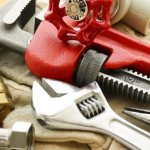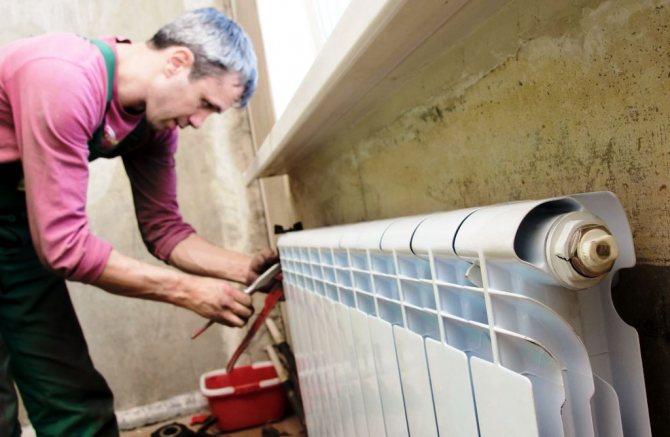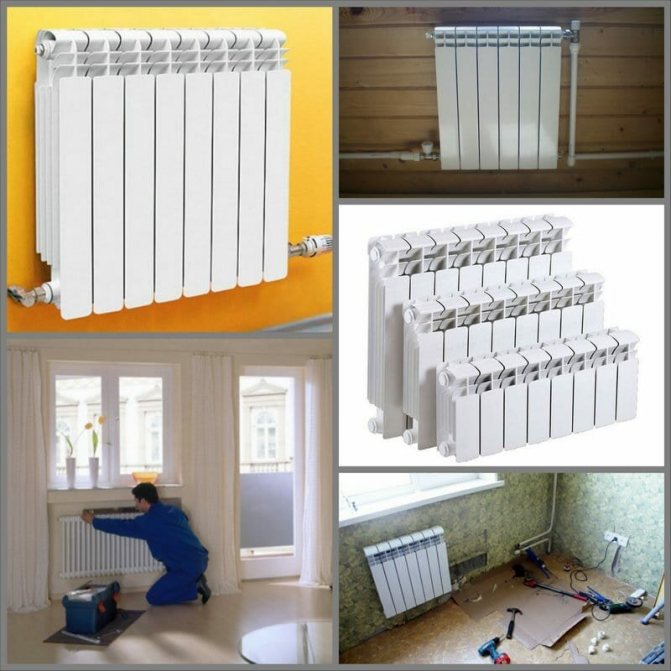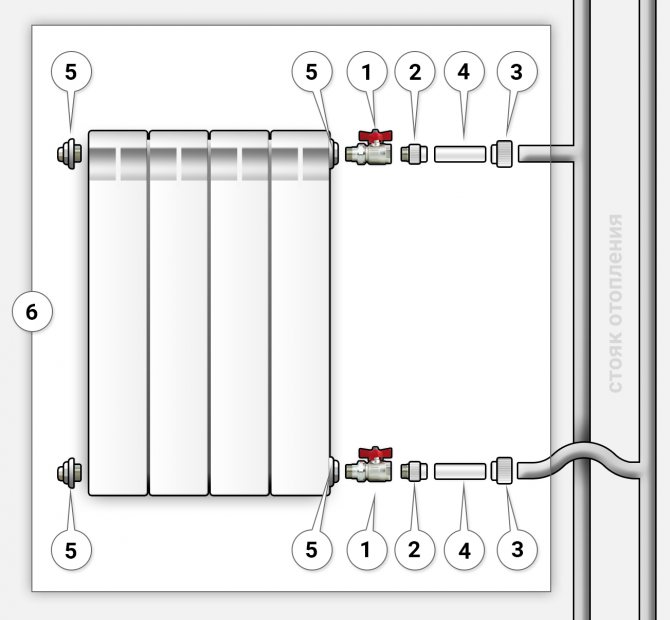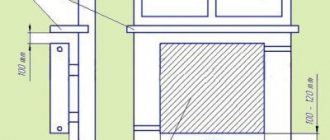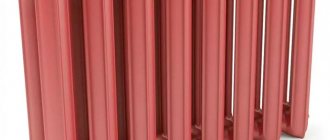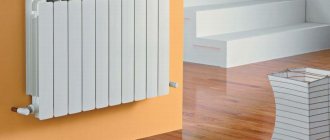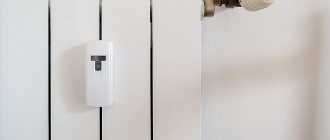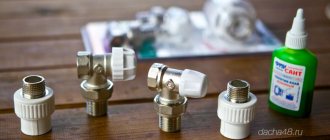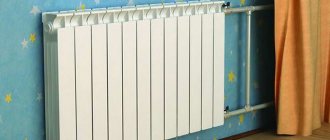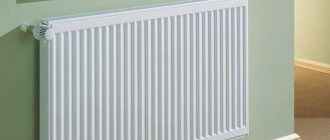Common causes of radiator malfunctions
Incorrect model selection. The choice of the type of battery depends on the diameter of the pipes, pressure and temperature of the coolant. Repair of heating radiators can be the result of an incorrect connection to the pipes. If there is a large amount of chemical impurities in the coolant or pressure drops occur too often, the metal of the battery corrodes. Low-quality water contributes to the formation of plaque at the joints of the radiator sections, and also clogs the pipes, which entails the need for cleaning. Repair of heating batteries is often necessary due to the destruction of threaded nipples
To prevent the leak from catching you by surprise, it is important to systematically change the gaskets. Battery noise - if you hear clicking sounds, this does not always indicate a malfunction. However, it is better to call a team of plumbers who will carry out soundproofing. Air pockets are caused by low pressure or leaking pipes. Due to scale in the boiler and a leak at the junction of the pipes, pressure drops.
Repair of radiators in Moscow
A reliable company that repairs radiators in Moscow should provide services quickly, inexpensively and efficiently. For this, specialists with extensive experience and professional equipment are available to carry out all types of radiator repairs. The main activity of "AUTOCOM" is the repair of car cooling radiators. AUTOCOM is a mobile radiator repair workshop.
Why repair radiators need to be done with us
The extensive experience and knowledge of the company's specialists allow us to quickly diagnose the radiator and determine the cause of the breakdown. Clients trust us, as we have all the modern repair technologies. This is also why we are ready for any turn of events during the inspection.
The company repairs all types of cooling radiators:
- Passenger cars,
- Trucks,
- Motorcycle;
- Repair of special equipment radiators.
Which radiators are repaired by AUTOCOM
- Aluminum;
- Brass;
- Copper;
- Plastic radiators.
What equipment is used for repair
In our work, in order to repair radiators in Moscow, we use Dimet metal spraying equipment. It allows you to eliminate radiator leaks without damping thin tubes, but preserving them. This is a very important point, since we are faced with the consequences of unprofessional interference in the work of the system on a daily basis.
What to do if a radiator breaks down
Are your cooling radiators, air conditioning radiators, oil coolers or intercoolers out of order? The surest way to fix this problem is to contact a professional. Call us on the phone. Explain the essence of the problem, and we will offer you several solutions.
The radiator repair workshop carries out work according to the following scheme:
- You always have a choice, since you can order a repair service on the road, or come yourself to our workshop. Be sure to contact us by phone before arriving.
- Within 15 minutes, the wizard diagnoses the malfunction. Free diagnostics are a nice addition to the professional performance of our work. During diagnostics, the radiator is checked under pressure for antifreeze leaks.
- When the pressure testing and determination of faults have been made, you will receive suggestions from us on options for eliminating the damage.
- We do not perform any work without agreeing on the price of repairs.You can check our price list in advance for your convenience. When the cost of repairing the radiator has been agreed, we proceed.
- Your radiator is being repaired.
- After repairs, the radiator is pressure tested again to avoid any unpleasant surprises during operation.
- You pay for the services rendered, and we give a one-year guarantee for the work performed.
Departure to the place of repair
For the convenience of our clients, we offer a service such as Departure to the place of repair. Regardless of your location, whether it is a garage, service or construction site, whenever possible, we carry out work on site. The fact is that for such cases, our cars are fully equipped with all the necessary equipment for the repair of radiators.
Repair of radiators in Moscow in AUTOCOM is convenient
You can find out more about the timing, cost and features by calling us on one of our phone numbers:
- +7
- +7
Preparation for disassembly
At this stage, you need to prepare all the necessary tools and dismantle the battery from the attachment point. For work, depending on the type and condition of the radiator, you may need the following tools:
- radiator (nipple) key;
- an adjustable wrench or a set of wrenches with different head sizes;
- autogen or grinder;
- construction hair dryer;
- hammer, sledgehammer;
- chisel.
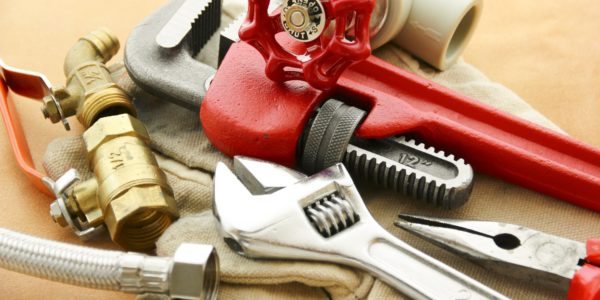
Disassembly tools for radiators
The nipple wrench is an iron rod with a spatula-shaped head at one end and a hole or curved "ear" at the other. The tool purchased from the store has serifs, the distance between which is equal to the width of the heating radiator sections. They will help you find the location of the desired nipple nut.
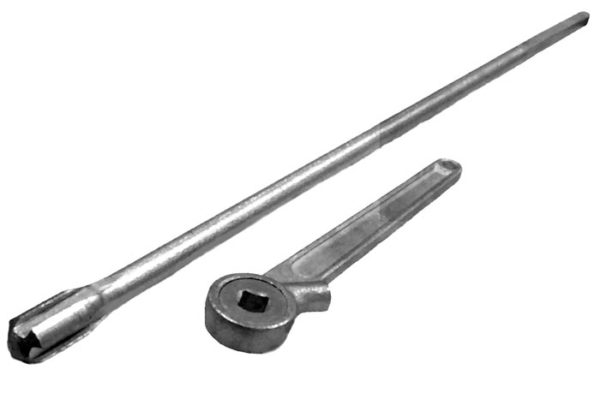

After preparing the tools, it is necessary to equip a place for disassembling the radiator. A floor or a sturdy table will do. It must be borne in mind that dirty water will flow out of the battery, and do not forget to put a waterproof cloth under it.
Assembling aluminum radiators
Aluminum heating radiators - general information and characteristics
In the 80s of the twentieth century, a model of an aluminum heating radiator was introduced to the world market. Compared with such a familiar product as cast-iron batteries, this type of heating device had a number of serious advantages, as a result of which it quickly gained popularity among consumers. Indeed, an aluminum heating radiator has a number of characteristics, due to which it is considered one of the most convenient heating devices. Let's consider these characteristics in more detail:
- Aluminum is a material with excellent thermal conductivity, as a result of which products from it can be used in systems with an unstable coolant pressure. Half of the heat is transferred by radiation, half by thermal convection;
- Light weight - this simplifies the installation of this type of device, as well as their transportation and maintenance;
- Durability - aluminum heating radiators withstand a pressure of 16 atmospheres;
- Low cost - devices of this type are much lower than similar bimetal or copper products;
- Possibility of regulation;
- Aesthetic appearance.
- Aluminum is a chemically active metal and lacks corrosion resistance;
- In prefabricated models, it is impossible to use any other heat carrier, except for water with strictly maintained acid-base characteristics;
- Aluminum radiators tend to be airy. Therefore, it is periodically necessary to bleed air from the system;
- The threaded connection in such models is a weak point.A water hammer may compromise the tightness of the product.
- solid;
- prefabricated, consisting of separate sections. If desired, they can be increased - add additional sections, or vice versa, remove them.


Thanks to all these characteristics, aluminum radiators quickly conquered the market and began to be widely used for space heating.
However, along with the advantages, these devices also have a number of significant disadvantages:
Aluminum batteries are available in two types:
Dismantling aluminum radiators
Disassembling an aluminum heating radiator is required, as a rule, in cases where:
In order to disassemble the product, we need a set of wrenches, a screwdriver and a radiator wrench.
The first step is to dismantle the battery from the place of its attachment. To do this, we perform the following actions:
The next step will be to disassemble the battery itself into separate sections. You should be aware that the connection of the battery sections to each other is carried out using nipple-nuts - these are empty inside nuts with external threads on both sides and grooves for mounting inside. For this purpose, we use a radiator wrench specially designed for working with nipple nuts. If necessary, you can make it yourself. This is a key with a serrated blade on the rod - the distance between them matches. That is, by checking how many serifs the key went inside, we can find out which nipple-nut we are turning at the moment.
By placing the vane in the slots of the corresponding nipple-nut in the hole at the top, we make a couple of turns counterclockwise. Then we take out the key, insert it into the hole from below into the grooves of the corresponding nipple-nut and also turn it a couple of turns. Then we return the key to the upper nut and repeat everything until the sections separate.


Unscrewing the nipple nuts in this way is necessary to avoid skewing. In order to be able to apply the necessary force, there is a through slot at the end of the key, into which, if necessary, insert a metal rod as a lever.
After we managed to disassemble the radiator, we clean it inside, change the gaskets and seals. If there is a need to build up the battery, you need to add the required number of sections.
If it is necessary to eliminate the leak, we prepare a special solution - add bronze powder to the epoxy resin and mix thoroughly. We clean the damaged area with a cable, after which we process it with the prepared composition and wait 30 - 60 minutes until it dries completely. When working with this composition, everything should be done so quickly so as not to let it dry out ahead of time.
After completing all the necessary operations for servicing the product and eliminating faults, it is necessary to assemble the battery and perform its installation.
Assembling aluminum radiators
The sequence of actions when assembling the aluminum radiator:
Conclusion
So, we were able to make sure that it is not very difficult to disassemble and then assemble an aluminum radiator. All operations should be performed very carefully - aluminum is a very soft metal and it is very easy to damage it. To carry out the work, no special construction skills are needed - only a set of the simplest tools, attentiveness and accuracy. Thus, if you need to service the product or add a certain number of sections, you will be able to cope with this task on your own.
A source
Wake up sleeping lithium-ion battery
Lithium-ion batteries contain a protective circuit that protects the battery from over-discharge accidents. The transition to sleep mode can occur when the lithium-ion packaging is stored in a discharged state for any period of time when the self-discharge gradually depletes the remaining charge. Depending on the manufacturer, the Li-ion protection circuit is disconnected between 2.2 and 2.9 V, and you need to know how to repair the laptop battery in this case.


Some chargers have a wake-up or “boost” function to re-enable and recharge batteries that have “fallen asleep”. Without this provision, the charger renders them unusable.
Boost applies a small charging current to activate the protection circuit. If the correct cell voltage can be reached, the charger starts normal charging. If storage of lithium-ion batteries presents a clear uncertainty, then manufacturers recommend keeping them in a 40-50% state of charge. But at the same time, they warn about the possible loss of the device due to excessive discharge. There is a wide range of action between these criteria, and if the user is in doubt, it is better to store the battery with a higher charge and in a cool place.
Reviews about Heating radiator repair
12/21/2017) the apartment looked like this: The floor with a new parquet board was brought to the state of coverage in a public reception after several years of operation.This is due to the fact that the manager of the company, Tatyana Salienko, for some reason decided to lay the board not at the very end of the work, as is normally done, but two months before their end. During these two months, the floors were covered with construction waste, which was constantly walked on. How useful this is for varnishing wood, I think, there is no need to explain to anyone. There are scratches everywhere, as well as fine dust hammered into the structure of the tree and the joints between the boards, making everything whitish. Parquet restorers (yes, you heard right - restorers), who tried to fix the plank initially crookedly laid by the company's employees on the second call, said in a private conversation that in the current state, by and large, all this simply needs to be thrown out. Almost not one installed baseboard does not adjoin tightly to the walls or floor and does not hold normally. Slits from 2-3 to 6-8 millimeters. It is understandable - the wooden plinth is as smooth as a ruler, but everything else, especially the floor, is not very good, to put it mildly. In one of the rooms the walls are not painted normally. Light and dark places are perfectly visible. Also from under the wallpaper along the plane of the wall there are clearly visible "pimples". On only recently painted ceilings, they managed to set stains and chips. The slope on the kitchen window is not normally putty or leveled, and then it is simply smeared with a brush. Part of one of the battery niches is painted with a different color. Plumbing is not fully completed. My faucet is not worth it (it was left "rough"), the toilet seat is not installed. No outlet taps are installed in the kitchen. When checking it, it turned out that the siphon installed on the sink in the bathroom simply flows like a stream. It's good that, for some premonition, before opening the water in the sink, I decided to open the cabinet under it. New heating radiators are not connected according to standards. The thermostat valves are installed from a two-pipe heating system, although I have a one-pipe one. As a result of all this, the batteries work 20-30 percent. In the new electrical panel, two machines do not work. White construction dust is so ingrained into the grout of tiles on the floor in the kitchen, hallway and bathroom that one can only guess that it was dark brown in a past life. "Cleaning" this situation did not change. Also, all the flooring, both the board and the tiles throughout the area, are stained with stains of building mixtures and paint. The new bathtub and toilet that I bought and provided for installation, which the workers used during the renovation, were not only not disinfected, but not even properly washed. By the way, no one - neither the workers nor the management of the company asked me for permission to use my plumbing. The call is not established, the installed intercom handset does not work, the TV antenna cables are not connected and are just lying on the floor. This is with regard to imperfections and the quality of work. Now for property damage.
Plastic windows installed 3 years ago and which were not planned to be changed, which was agreed before the start of the repair, were brought to a deplorable state during the repair. During the renovation, no one tried to cover them somehow. In the summer, the constantly open sash banged against the dismantled slopes, despite my repeated remarks to the workers. Now all the mechanisms do not work well due to contamination with construction dust, some of the sashes are not pressed well, all frames and hinges are literally filled with paint and compote from all used building mixtures. There is no plastic cover on one and the hinges. And finally, one of the double-glazed windows is simply damaged - the entire inner side is scratched. It looks like this if someone rubbed the glass with coarse sandpaper. The wooden window sills ordered and installed by me at the beginning of September are chipped. On the new kitchen I ordered and installed just a week and a half ago, there are several well-visible deep scratches on the artificial stone countertop.On the new stainless steel hob too.
Despite this entire list and the fact that the vast majority of these problems were well known to foreman Alexei long before, manager Tatyana Salienko urged me to sign the acceptance certificate, which I naturally refused. Based on the results of the inspection with the foreman, a list of defects was drawn up. Further, from Friday 12/22/2017 silence. No work is being done. No one can decide anything, decisions in this company are made only by the director. The director of the company, Dmitry Volkov, has been absent from Moscow for about two weeks. I did not get in touch and did not respond to messages and answered only after my statement in an ultimatum tone. The essence of the answer is that I don’t, we have 5 working days for consideration, at least until Monday I can’t help. The company does not want to finish anything and is deliberately wasting time. He also refuses to acknowledge the damage. Currently, my lawyer is preparing an official claim and a statement of claim to the court.
The apartment for the next few days will be in the condition in which it was offered to me for acceptance. I invite everyone to evaluate the "quality" of the company 's repairs Thought over for the excursion. Geographically Moscow, South-West Administrative District, Kotlovka district. Those who wish to write Also write to anyone who simply has some questions or who, like me, suffered from the actions of this company.
For some time, all comers have the opportunity to personally see everything and decide for themselves whether they need such a "no-problem repair" and "turnkey repair". After some time, all imperfections and problems, as far as possible, will be eliminated by another company.
P.S. Also, a detailed description of the entire repair process is being prepared from the company Thoughtful from and to with an extensive photo archive. A very exciting story. There will be two teams of workers dismissed for krivorukost, a dismissed foreman, a missing (with money) foreman, an apartment littered with cigarette butts at the initial stage of the final finishing, despite the strict ban on smoking, a pigsty on the site and a construction company lack of a vacuum cleaner, quotes from correspondence with employees and much more.
DIY HP laptop battery repair
Laptop batteries are made up of lithium cells called 18650 cells. They do not last forever and have a lifespan of about 2 years. If the laptop is fully charged but does not even charge for half an hour, then the cells inside the battery are dead.


With your old laptop battery in stock, some wires and tools like a wire cutter and electrical tape, you can start rebuilding your laptop battery yourself:
- Open the old battery and take out 6 cells, which are in parallel connection 2 x 2.
- Check the voltage with a multimeter of your own battery. Typically, a battery voltage less than 3.6 volts indicates that they need urgent replacement.
- Using one wire, connect all cells in series. The circuit should provide about 12 volts.
- Open the original block, remove the faulty cells and, keeping the circuit, replace them with working cells.
- Collect the circuit on your own battery. The battery pack will also have 4 wires - 1 negative and 3 positive (one attaches to the end and two between the battery pack).
- Check the circuit with a multimeter before closing the unit.
- Close the battery case, insert into PC and start charging.
Safe removal
Before disassembling, make sure the laptop battery is completely discharged. Once the charge is completely depleted, you need to double check the laptop before removing the battery
It is important!
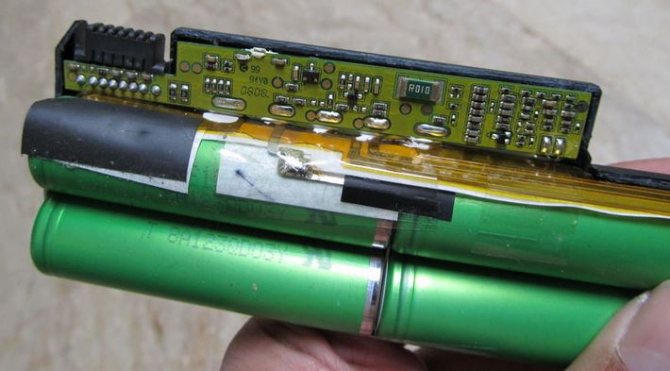

Do-it-yourself Asus laptop battery repair procedure:
Open the battery case
To do this, carefully unpack it using a flat screwdriver and a utility knife.After the battery case is open, you can analyze the type of batteries needed and learn the connection diagram for installing them.
Before disassembling, it is better to take a picture or draw a diagram of the connection of the elements, so as not to forget before restoring it It is also important to take all measures when opening to prevent deformation or breakage of the plastic case of the battery. Replacing Cells Use a voltmeter to make sure old cells are fully discharged before removing them. This will prevent possible electrical shock. Use the model number on the battery to find the correct replacement cells. Solder the new cells to the wires, making sure they connect to the correct wires. Safety glasses are used when replacing lithium-ion cells. They are handled with care as they can explode. Once the battery case is closed and placed back in the laptop, it needs to be fully charged.
Dismantling the cast iron battery
At first glance, disassembling a cast-iron battery with your own hands is quite simple, but it is not. So, first you need to heat the plugs on the battery, for this I use a blowtorch. After the plugs have heated up, they can be unscrewed much easier than without heating. (See also: Cast iron heating radiators)
With the help of a grinder, the battery is cut very carefully between the sections. After cutting, the radiator sections are disconnected
In cast iron batteries there is a nipple that must be carefully knocked out of the battery using a chisel. This is required if you decide to clean the radiator or replace a separate section.
With a complete replacement of the radiator, it is naturally not necessary to clean anything. It is enough to cut it with a grinder and take it out.


The nipple must be removed so that the thread is not damaged. It is subsequently thoroughly cleaned of rust. Further, the grouping and collection of individual sections is carried out. In order for the battery to have good tightness between the sections, you need to install gaskets and coat all joints with silicone. A little later, when everything is dry, the battery can be gently rinsed using a hose.
The design and principle of operation of cast iron radiators
The radiators are of sectional design. In appearance, the sections resemble metal columns, inside which channels for the coolant are provided. These elements are connected to each other using a nipple system. The joints are sealed with paronite or rubber gaskets. The height of the devices is 350-1500 mm, the depth reaches 65-500 mm. The power of the radiators depends on the number of sections and the heat transfer area. In rooms, cast iron batteries are placed under window sills. Usually wall mounts are brackets, but there are floor models with legs.
Depending on the model, cast iron radiators have a power of 100-300 watts. Approximately 25-35% of heat is transferred using radiation (radiation), part - convectively. Thanks to radiation, the heating is better: the radiator heats objects, and not just air. Warm air layers rise upward, and radiation provides heating to the lower part of the room. This creates the most comfortable temperature regime.


Joint repair
To carry out repairs you will need:
- special radiator key;
- gas wrench No. 2 or No. 3.


We will assume that the radiator is removed. It must be laid on a flat surface. Then the plugs and fittings (plugs with holes for pipes) are removed using a gas wrench.
The radiator sections are interconnected by nipples. It is a short cast iron pipe with an external pipe thread (half right, half left) and an internal hole that has two projections.
It is these protrusions that are the place where the edges of the radiator key will abut. In fact, these are stops.
At this stage, you will need an assistant who will fix the heating device in a stationary position. The key is inserted into the hole of the section so that the edges of the tool rest against the protrusions of the nipple. Now you need to turn the key with effort at least a quarter of a turn.
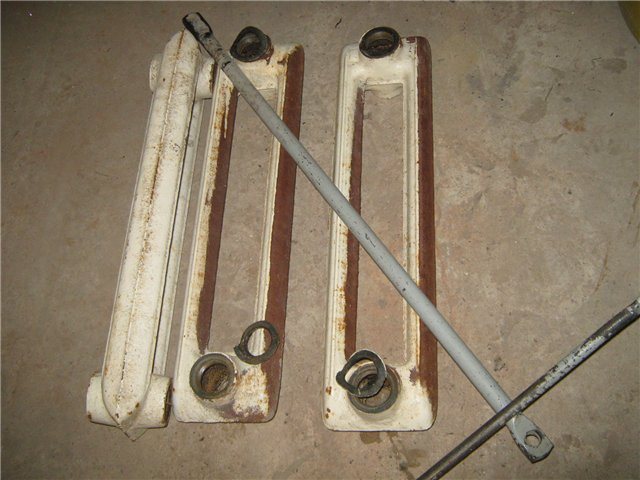

The thing is that the long-term operation of cast-iron batteries, where a coolant with a high temperature is used, creates conditions under which the nipple and the section of the device are soldered together. The result is a monolith.
Therefore, great efforts will have to be made to break these ties. As soon as the nipple moves slightly off dead center, move to the second parallel element. It is impossible to untwist the sections on one side only, a skew will occur, which will complicate subsequent operations.


This is how all sections are parsed. Now you need to clean the joint surfaces with an iron brush and sandpaper. Only the rust needs to be removed.
Be sure to inspect the nipples, if their condition is in doubt, then it is better to replace them with new ones.
Pay particular attention to the threads
It is best to flush the battery sections at this stage. A hose jet and a pin (wood or metal) will do the job perfectly.
After that, you can proceed to the assembly, having previously prepared the gaskets. They can be made independently from heat-resistant paranite or rubber 1 mm thick. Currently, craftsmen suggest using a silicone sealant that can withstand high temperatures.
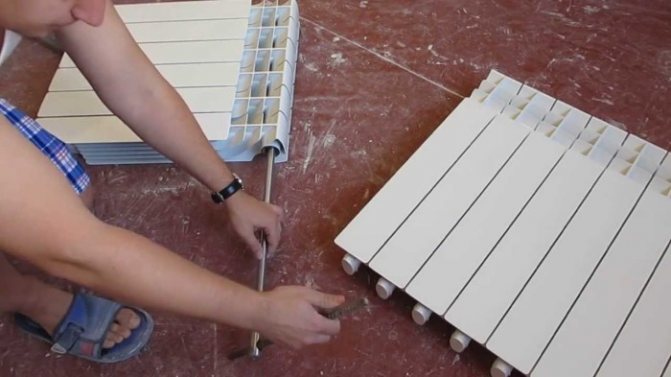

The battery is assembled in reverse order. Be careful when tightening the nipples
Here it is important not to twist, so as not to squeeze the gasket to a critical rate. She just might tear
As with disassembly, the two nipples must be screwed in alternately.
Situations often occur when the stops inside the nipple become covered with rust under the influence of long contact with the coolant. And under pressure from the radiator key, these stops are cut off. What to do in this case, because the sections simply cannot be promoted. Option one is to break the section on which the fistula appeared.
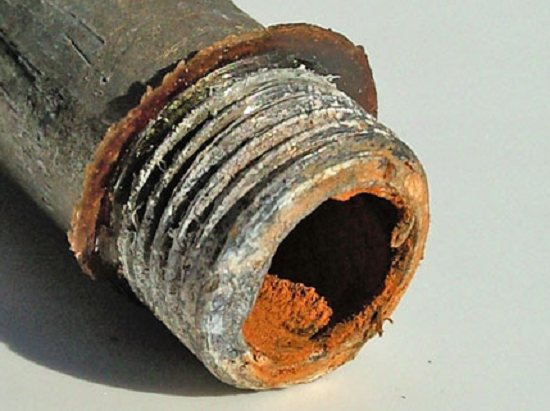

This can be done in two ways:
- Simply smash the battery section with a sledgehammer. Do this carefully so as not to break the good elements.
- Can be cut with a grinder. But the junction will still have to be broken with a hammer.
Installation of heating radiators in apartments and private houses
Installation of a radiator consists of the following steps:
- Assembling a new heating radiator. It is produced on a flat, even surface by tying individual sections on nipples with external threads. Next, the installation of the fittings and plugs is carried out. If necessary, the battery sections are built up. A Mayevsky crane is required for installation, which is necessary to bleed excess air from the system.
- Installing a new radiator... In accordance with the dimensions of the radiator to be installed, markings are made on the wall, holes are drilled for the brackets on which the new radiator is hung;
- Installation of shut-off and control valves on the radiator... To control the operating modes of the battery and regulate heat transfer, ball valves and thermostats are provided. The main installation conditions are easy accessibility and the absence of obstacles to the movement of the handle. The diameter and thread must match the diameter and thread of the pipe.
- Installation of a bypass (jumper). A necessary option in a one-pipe heating system. It is necessary so that if the battery is turned off, the coolant does not stop circulating through the riser. The bypass is installed between the inlet and outlet pipes and transports the coolant parallel to the shut-off and control valves.
- Connection to an existing heating system. The final stage of installation is carried out by welding or threaded connection. In residential premises, mainly threaded pipe connections are made.
Heating radiator installation diagrams
| One-pipe heating system | Two-pipe heating system |
|
|
|
|
Types and criteria for the selection of radiators
Currently, there are steel, aluminum, cast iron and bimetallic radiators. In terms of design, all radiators are divided into sectional, panel and tubular. The most widespread among customers are sectional radiators made of aluminum alloy due to their lightness and functionality. When choosing a radiator, you need to focus on the design (thickness of the radiator metal, alloy quality) and performance (level of heat transfer) indicators. Heat transfer is calculated based on the area of the room in the proportion: from 1 kW of thermal power / 10 sq. m. The power of one section of the battery usually ranges from 1.2 kW to 2.2 kW. If you need advice and assistance in the selection of a radiator and accessories for it, we will be happy to provide them.
Cost and conditions of installation
The cost of installing the radiator by our specialists is 2000 rubles. The price includes only plumbing works without materials. If you need to install a large battery, the price will directly depend on its size and weight. In this case, the exact cost is determined by our master when leaving the object. When installing more than five heating radiators, an individual discount is possible. The total cost of the entire radiator replacement event consists of the prices of materials, components and plumbing work.
How to assemble an aluminum radiator
Putting it up in reverse order. We place the sections on a flat surface (a table of a suitable size or simply place it on the floor). If the radiator is not new, we unscrew the end cap and the Mayevsky tap.
Before installation, the threads and grooves should be well examined, they must be of high quality, without chips and drops. On the section to be mounted for the sample, we "drive" the thread by screwing in-unscrewing the nipple
Here you need to pay attention to the fact that a gasket may be located in front of the thread under a layer of factory paint. Rub lightly the end with fine sandpaper, if it is found there, then it must be carefully cut off with a knife with a sharp blade


This is how an aluminum radiator looks like a cutaway.
Before adding sections of the heating radiator, be sure to clean the ends to a smooth surface. We even remove the factory paint. At the ends of the radiators, it is not needed, but will only contribute to the early manifestation of leaks. Sooner or later, coolant will begin to seep under the paint. In the case of non-freezing liquids, this will happen very soon, if water is used in the system, then not very much, but it will certainly happen. And then the coolant will begin to leak between the sections, although the gaskets are still in perfect condition. And the whole point is that the paint at the ends has exfoliated or corroded it, microcracks have appeared. So be sure to clean the ends to a clean metal, but use fine sandpaper to make the metal surface smooth and scratch-free. This ensures that the system operates without leaks in the radiators.
For better tightness, the ends then need to be degreased (you can use gasoline). The gaskets are also degreased, but they must be washed with ordinary soapy water. For a system that will be filled with water, degreasing is an optional procedure, and for systems that will operate on antifreezes, it must be carried out.Antifreeze is very fluid and seeps into the smallest pores. After everything is dry, we begin to collect aluminum radiators.
Then we bait both nipple-nuts by half a turn. On top of the nipple, heat-resistant paronite (silicone) gaskets are put on to seal the joints. Now we take the section that needs to be screwed and put it tightly on the nuts, checking the tightness of their fit. Next, insert the key into the upper hole and twist it 1-2 turns. In this case, we do not use the lever yet. We twist our hands. Then we do the same operation in the lower hole. We repeat several times, alternately tightening both nuts for several turns.
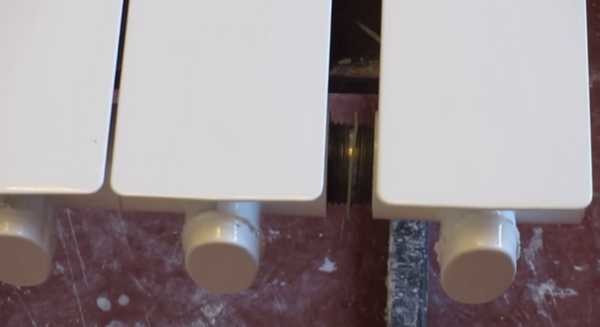

Unscrew the sections gradually, one or two turns of the nut, then from the bottom, then from the top
We twist as much as we have enough strength. Only after hand tightening can the lever be used. This must be done in two steps on each nipple. It is better not to apply excessive efforts during the final tightening of the nipples, since you can easily break the thread: aluminum is a soft metal, do not forget.
If the section is completely assembled, we screw the plug onto the unused holes on one side, and on the other - the Mayevsky valve (to release air from the system). Now you know how to assemble sections of a heating radiator and, if necessary, you can expand several sections.
There are many batteries, but the assembly method is one
We would like to remind you that batteries can be of several types according to materials:
- Cast iron;
- Bimetallic;
- Aluminum;
- Steel.
And several types of designs:
- Panel;
- Sectional.
For your information! The secret is simple: the method of assembling various radiators is the same + the method of strapping radiators is also the same. Therefore, today's material is universal for all types of batteries.
Let's start with the sections
Let's carry out the assembly using the example of sectional batteries. In order to somehow supplement the information, we will analyze the moments of tying radiators, especially since they are of the same type for sectional and panel heaters.
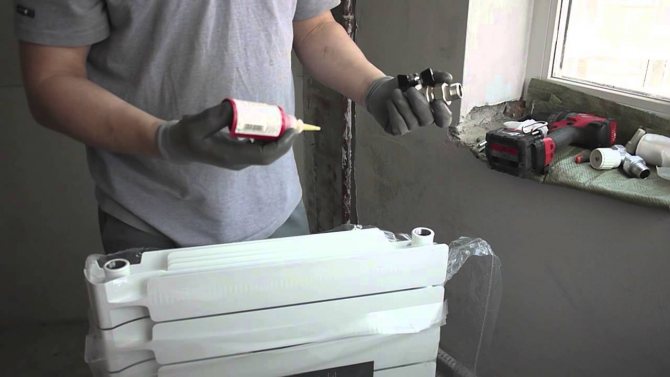

We put everything in its place.
The binding starts with the distribution of roles:
- Each radiator, regardless of type, has four threaded inlets. Our task is to decide on the circuit of the input-output of the coolant for the correct placement of the plugs and the competent connection of the element to the network;


Assembly diagram.
Advice! If you are making a conventional radiator replacement, then you don't need to come up with anything. You do everything in the same way as the previous radiator. Upper entrance, lower exit. The opposite upper threaded hole is a through plug with a Mayevsky tap. The opposite bottom threaded outlet is a blind plug.
- Roles are assigned. We assemble:
- The beginning is the connection of the Mayevsky crane and the blind plug. For these purposes, flax fiber and a special paste for sealing threaded joints are suitable;
- The fiber is wound in straight strands without lumps and ridges in the direction opposite to the direction of the thread of the plugs;
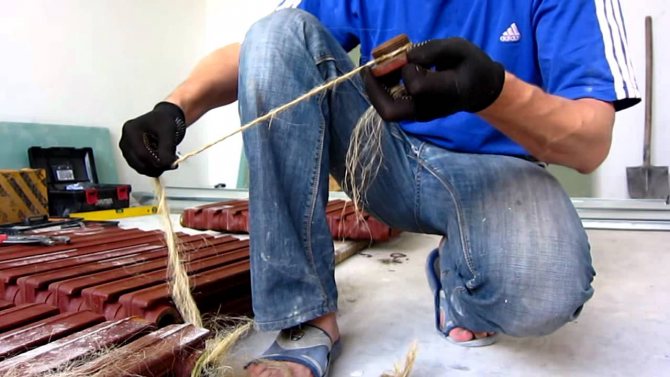

For additional sealing of the parts, we use fiber.
- Then the paste fixes this fiber in place;
- Using a wrench, the plugs are installed in place.
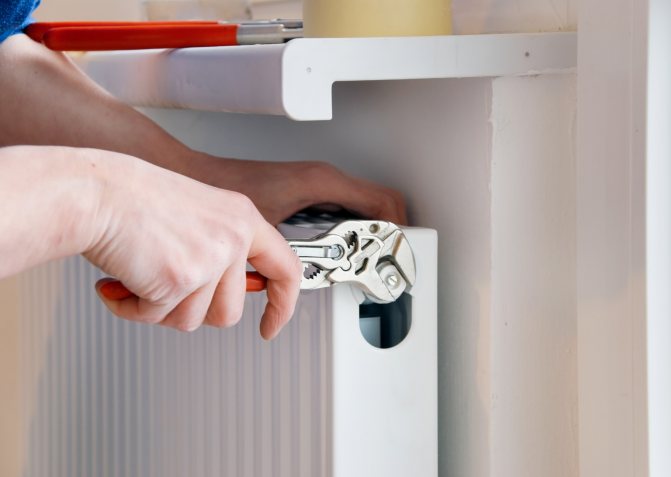

An adjustable wrench is a great helper.
Advice! On sale there are special keys with curly grooves for the main parameters of the mounting kit. An adjustable wrench is quite enough for strapping the radiator, although its capabilities will not be enough for plugs for cast-iron radiators. Then you still need a gas wrench.
- Slightly more difficult with water inlet and drainage. Today, the batteries are equipped with taps, called by the Americans, these connections with a union nut provide the most reliable connection. Their installation is as follows:
- The threaded part entering the radiator is formed in the same way as already described - with fiber and paste;
Recommendations! Flax and pasta can be replaced with FUM tape, as many advise. Indeed, it is possible, but it must be done competently. Such a replacement is possible in houses and apartments where there is an autonomous heating system, where the coolant pressure in the network is low enough - the circuit is closed. FUM tape feels very comfortable in such conditions. With pressure surges, frequent guests of the general heat supply system, the tape can collapse. The result is clear - to flow.
- The American woman is twisted not with an ordinary gas wrench, but with a hexagon.
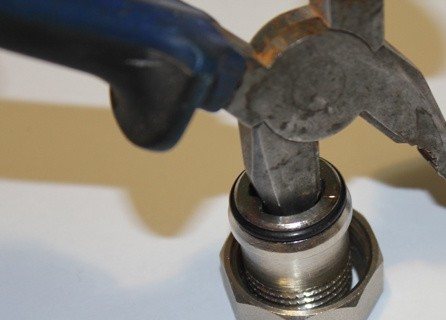

Is the replacement possible?
Advice! In many videos you can see how an American woman is screwed in with a chisel, a square pin, and even one grip from a plier. We will not judge how justified this is, but the native key is still better.
Connecting sections
To do this, we need nipples - special section connectors with a sealing rubber ring, as well as wrenches for tightening the nipples.
Our help! A nipple is a type of connection represented by a pipe segment with a central transverse groove for a rubber seal. Ridges with thread for the right and left sides extend from the furrow. This design allows the connector to be screwed into the threaded sockets while simultaneously bringing the radiator fins towards each other.
How to assemble heating radiator sections?
The assembly algorithm is simple:
- Assembling sections of aluminum radiators, as well as assembling bimetallic heating radiators with your own hands, begins with "baiting" the nipples in the threaded holes;
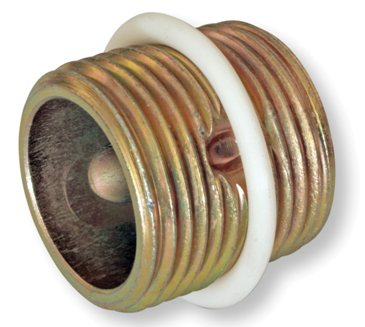

Photo of a nipple with a seal.
Advice! If you are connecting two sections, then the docking windows must have: one - right-hand thread, the other - left-hand thread.
- The assembly of aluminum heating radiators, as well as the assembly of cast-iron heating radiators with your own hands, is carried out by uniformly tightening the threaded connections of the nipple and sections using special keys;


Keys for assembling ribs.
Observation! It is better to carry out work on installing batteries together. It is both easier and easier to control the connection.
- After joining the required number of sections, the assembly of an aluminum radiator, like any other, is carried out according to the strapping scheme, which has already been described.
A few words about the mount
We have already described how to assemble bimetallic radiators, how to assemble an aluminum radiator. The type of constructor is unimportant, the assembly of the ribs occurs according to a similar principle with your own hands. And here it is also better to work together.
Advice! If you are changing, for example, a cast-iron radiator to a steel panel one, then the types of fasteners for cast-iron structures will not suit you. They must be removed and new ones installed. Fortunately, they are in the sets of panel heaters. And while one person is doing a rough docking, the second can mark the places of future fastenings.
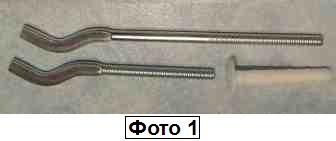

All that is good for sections is not good for panels.
In the piggy bank. If you do not connect the batteries to the riser, but connect to an autonomous system, then the masters advise to make a slight tilt of the battery about 5 degrees so that the Mayevsky tap is slightly higher than the inlet connection with the coolant supply. The result of such a connection is that if air accumulates in the system, it will be at the tap, and not be located above the water flow along the entire perimeter of the pipe.
Disassembling old batteries
The wrench is required to assemble and disassemble the cast iron battery.
To disassemble old cast-iron batteries, since the thread sticks in them, they must be heated at the location of the nipple with an autogen or blowtorch. Heating is done in a circular motion at the location of the nipple, sequentially heating the parallel joints of the battery.
After warming up the joints, while they are hot, a radiator key is inserted inside and about half a turn is made, then the key is quickly rearranged into another nipple.
In the same way, sticky plugs and footwear are turned out of cast-iron batteries.
Sometimes it is impossible to unscrew the nipple, due to the fact that its turnkey protrusions are completely eaten away by corrosion. In this case, the sections at the joints are cut with a hacksaw for metal or a grinder. Then cut nipples are turned out of the sections by heating. Then the thread is cleaned with a metal brush.
If the old heating radiator cannot be untwisted in the above ways, then one thing remains - with the help of a sledgehammer, break part of the sections. To do this, place the battery horizontally on the floor, and hit the middle of the sections with a sledgehammer until a through piece of the section breaks off. Then the battery is turned over to the other side and the other half of the section is broken.
After that, the cast-iron radiator is installed in a vertical position and blows are applied to the remaining pieces of the sections, then they are untwisted. However, when performing this operation, the heating radiator loses its tightness at other joints. And you can lose half the battery.
Dismantling and disassembling cast iron radiators is not an easy process, but sometimes it is necessary, so it is very useful to know how this operation is performed correctly.
Heating radiator designs
If a heating element breaks down, especially in the cold season, it must be repaired or replaced immediately. Whether the radiator can be disassembled depends on the type of its design. Quite often, non-separable types of radiators are installed in apartments, which cannot be restored. In this case, it is best to purchase a new battery right away. But there are also collapsible models that can be dismantled to replace the damaged element and installed back.
Products are divided into two main types:
- Sectional batteries assembled from several identical sections, securely connected to each other. Each of them has a channel through which water circulates, and fins that radiate heat heat the room. Sectional batteries are the most popular because the cost of such radiators is lower. In the event of a breakdown, it is enough to replace only the damaged section, and if necessary, you can always add or remove ribs.
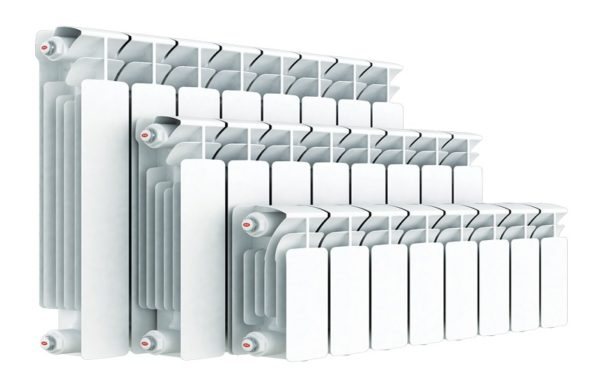

Sectional heating batteries
- Monolithic products represent one solid structure, which does not have separate sections. Outwardly, these radiators may resemble sectional counterparts, but the differences between them are obvious. In monolithic devices, there are no connecting joints, due to which they are able to withstand more pressure. From this, the terms of failure-free operation of these structures are almost twice as long as those of sectional ones. But in the event of a leak, the monolithic device will have to be changed completely. In sectional products, it will be enough to replace the damaged element.
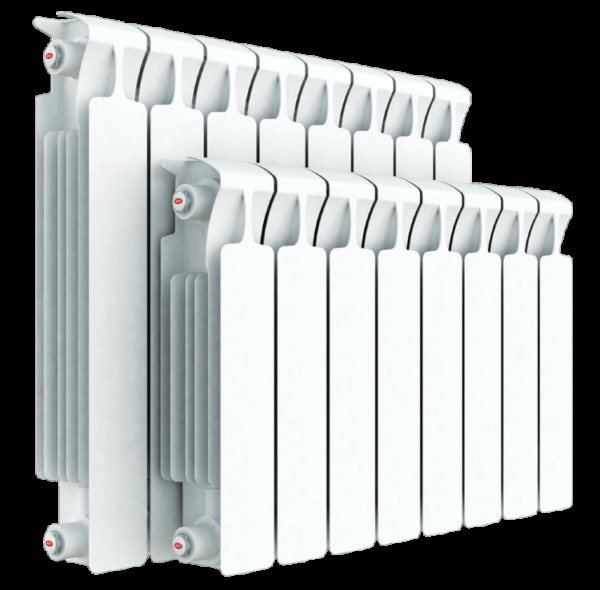

Bimetallic monolithic radiator
Reasons for poor performance of radiators
One of the most common causes is salt and rust deposits inside pipes and batteries. Our technicians will flush pipes and repair batteries, removing all blockages.
Violations are possible during the installation of the heating system - the battery itself is leaking or leaking at the joints of the pipes. This will lead to a decrease in temperature, since the batteries will not be completely filled with the coolant, that is, water. In this case, urgent repair of radiators in an apartment or office is needed.
Whatever the reason, our specialists will completely eliminate it and carry out a high-quality repair of the batteries, and, if necessary, the entire heating system.
DIY cast iron radiator repair
Typically, the leak is easily identified. If there are difficulties with diagnostics, the radiator is removed, immersed in a bath of water and monitored for the appearance of air bubbles. The place from which they rise is not airtight. When a leaking area is identified, materials and tools should be prepared:
- thin metal cable;
- putty;
- a piece of cloth;
- metal clamp or something that can replace it: electrical tape, wire, etc.


Work order
- Cover the floor with oilcloth, put a rag on top to absorb excess moisture.
- With a thin cable, clean the leaking section of the radiator to metal, degrease with any solvent or gasoline.
- Cover the leak. Apply the putty to a strip of fabric and wrap tightly over the damaged area in several layers. If metal powder or epoxy resin is used as a putty, then 2-3 layers are enough. If zinc white is 4-5. Cold welding is also used as a putty. No fabric is needed for her.
- Place a metal clamp on the putty, tighten with bolts and nuts. Make sure that the connection is on the opposite side of the leak. If electrical tape is used instead of a clamp, wind it in several layers and secure with wire.
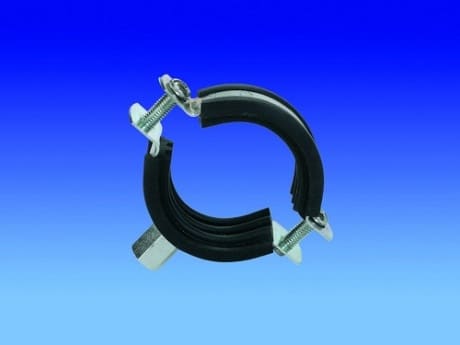

Repair of cast iron batteries is not difficult, does not require special knowledge and skills, but if you have doubts about your abilities or a leak is really serious, it is better to contact a specialist. It makes sense to replace old radiators, which have leaked more than once, otherwise their repair will become a constant activity during each heating season.
Renovation work
Every heating device that heats an apartment building needs preventive maintenance and repairs over time. Preventive maintenance of equipment is carried out at the discretion of the owners, but at least once a year. Repair work is carried out when the need arises. The best time to replace outdated or outdated heating devices is during the overhaul of the entire apartment building. In the event of an emergency, replacement is carried out immediately after the occurrence of a breakdown.
In the apartments of multi-storey buildings, it is not uncommon for the need to begin to perform various types of work. After assessing the condition of the heating system, you can see how much money will need to be invested and how long it will take to repair the required area. According to experts, when repairing the heating system in an apartment, repairs should be carried out in stages.
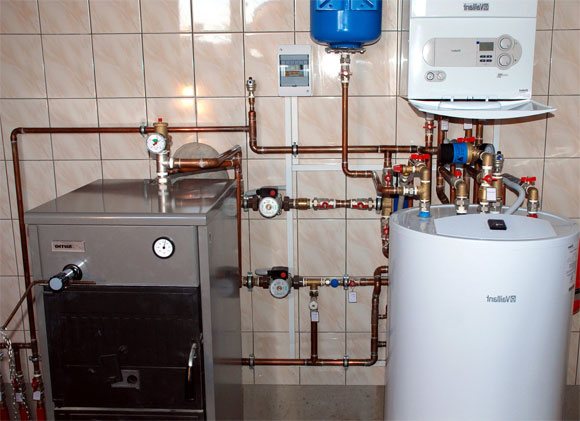

Here is a rough plan for repairing cast iron batteries:
- shutting off the water supply to the heating device, it is necessary to drain the coolant;
- after that, the radiators are removed from the brackets;
- repair of the heating riser in the apartment;
- if necessary, flush the insides of the pipes;
- if there are damages in the shut-off or control and measuring valves, then repair or replace them;
- installation of heating devices. If necessary, install additional equipment;
- to carry out pressure testing - test work, which is carried out at the established working pressure;
- after, the system is checked for operability;
- the heating system is being painted.
If possible, it is better to postpone such work for the summer period, this approach gives the advantage of combining it with the renovation work of the apartment.
We recommend: How to repair the expansion tank of the heating system?
